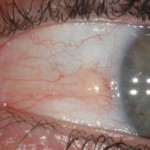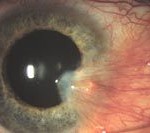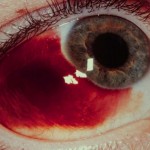There are two types of benign growths that can appear on the white of the eye (conjunctiva).
 The first type is called a Pinguecula. A pinguecula is a benign growth caused by the degeneration of the conjunctiva’s collagen fibers. Thicker yellow tissue and in some cases calcified deposits, eventually replace the original fibers. It often appears as a thickened, discolored spot between the colored part of the eye and the nose. It is more common in individuals who spend a lot of time outdoors with continued exposure to the ultraviolet light or those who live in sunny, windy equatorial climates. The affected eye might become red and irritated. No treatment is necessary unless discomfort is severe. Prevention is highly recommended and that means sunglasses when outdoors. Artificial tears can help with irritation.
The first type is called a Pinguecula. A pinguecula is a benign growth caused by the degeneration of the conjunctiva’s collagen fibers. Thicker yellow tissue and in some cases calcified deposits, eventually replace the original fibers. It often appears as a thickened, discolored spot between the colored part of the eye and the nose. It is more common in individuals who spend a lot of time outdoors with continued exposure to the ultraviolet light or those who live in sunny, windy equatorial climates. The affected eye might become red and irritated. No treatment is necessary unless discomfort is severe. Prevention is highly recommended and that means sunglasses when outdoors. Artificial tears can help with irritation.
The second type of benign bump on the eye can actually be more problematic. A Pterygium is an elevated, triangular, non-cancerous  growth that is also usually on the nasal side of the eyeball. A pterygium contains blood vessels and can be of greater cosmetic concern than the pinguecula. The difference between a pterygium and a pinguecula is the tissue they invade. The pinguecula is limited to the conjunctiva and the pterygium grows onto the cornea (clear part of the eye). A small pterygium is treated with artificial tears for comfort and sunglasses for prevention. Sometimes surgery is needed if the vision is affected.
growth that is also usually on the nasal side of the eyeball. A pterygium contains blood vessels and can be of greater cosmetic concern than the pinguecula. The difference between a pterygium and a pinguecula is the tissue they invade. The pinguecula is limited to the conjunctiva and the pterygium grows onto the cornea (clear part of the eye). A small pterygium is treated with artificial tears for comfort and sunglasses for prevention. Sometimes surgery is needed if the vision is affected.
Genetics can play a role in the possibility of having either of these bumps. Wearing protection from UV is your best chance of preventing or controlling pinguecula and pterygia.
